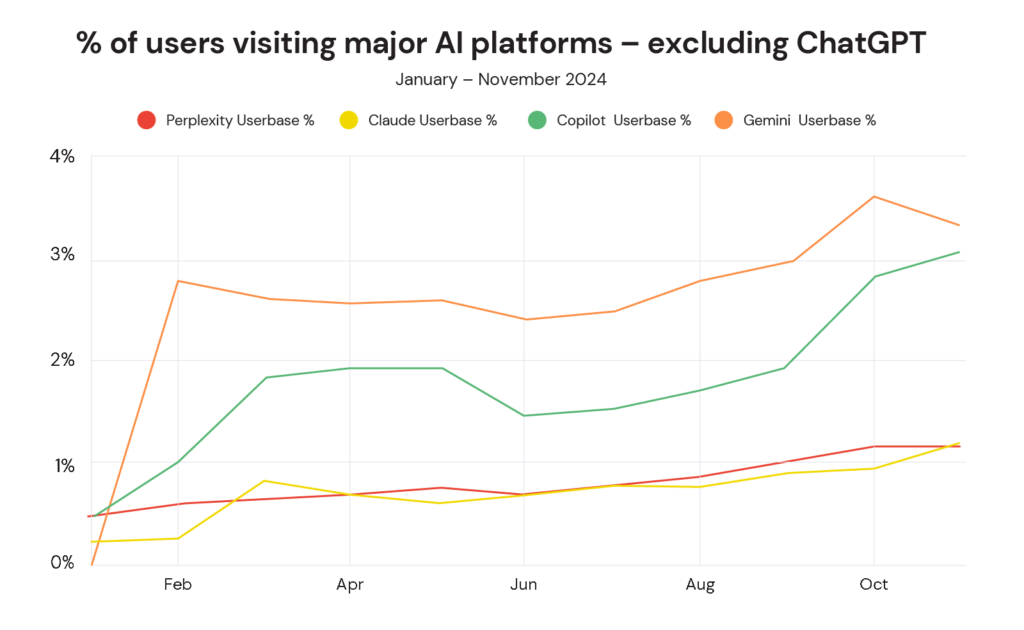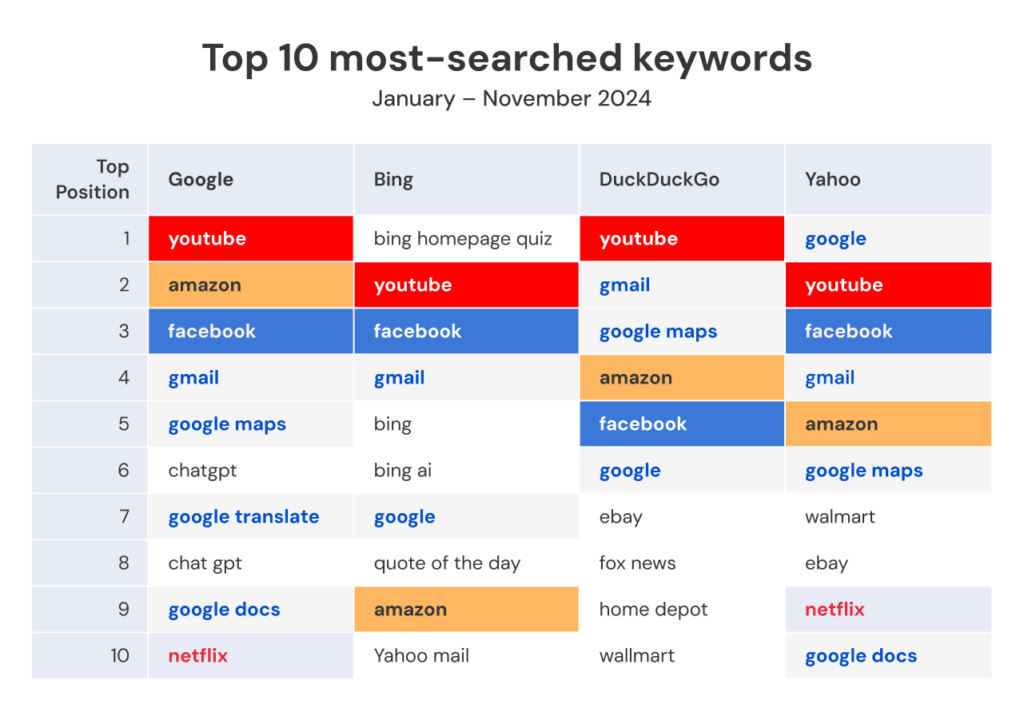As we approach the end of another eventful year, we’ve taken some time (and data pulls) to reflect on the past year, and observe what key trends have shaped the digital landscape in 2024.
At Datos, our clickstream has provided a front-row seat, allowing us to capture and analyze the most significant user behavior trends in AI usage, search behavior, and retail dynamics. In this year-in-review, we’ll delve into the data trends that dominated 2024.
From the ever-expanding growth of AI adoption to the shifting battleground between retail giants Amazon and Walmart, we explore how these trends have unfolded and what they mean for the future of data-driven decision-making.
We start with a summary of the key findings this past year, followed by a deep dive into the data, and finally our CEO Eli will round things off with his predictions for the coming year.
Key Highlights
- AI usage continues to grow, with all 5 major platforms (ChatGPT, Gemini, Claude, Copilot, and Perplexity) seeing increases in their userbase and average number of sessions per user. ChatGPT is the most popular by a long shot.
- For AI-related search terms, navigational searches (where users enter a specific brand keyword in order to navigate to that site) occur 8 times more than non-navigational searches (e.g. where users are looking for information or to make a transaction).
- In major search engines (Google, Bing, Yahoo, Duck Duck Go), navigational search terms dominated across all search platforms.
- Retail is going steady: over the last year both Amazon and Walmart saw slight increases in purchase rates (percentage of retail visitors who made purchases).
AI tools: adoption and use
It wouldn’t be a year in review without exploring the topic that is still on everyone’s lips. Artificial Intelligence continued to dominate headlines and transform industries in 2024.
As you can see from the graph below, adoption of popular AI tools has grown across the board in 2024, with ChatGPT seeing the most growth and also being the most popular AI tool by far.

Userbase % = (Number of unique users who visited website / number of unique users in our panel) * 100%
Gemini comes in at second place, with Copilot not too far behind, and Claude and Perplexity bringing up the rear.
ChatGPT is so far ahead that we plotted a second graph excluding it, to see the differences between the other AI tools more clearly.

A spike can be seen in the user base for Gemini in February. This was the month that Gemini was rebranded from Bard, so the extra attention from that release might explain this jump in numbers. We could conclude that the rebrand has worked quite well for Gemini.
Interestingly, the order changes a little when looking at the number of sessions per user. ChatGPT is still the clear leader, but Perplexity comes in at a much closer second place, followed by Claude.

In November 2024 the average sessions per user were:
ChatGPT: 9.25 sessions
Perplexity: 8.32 sessions
Claude: 6.64 sessions
Gemini: 3.68 sessions
Copilot: 3.10 sessions
While most major AI platforms exhibit steady growth in the average number of sessions per user, Gemini stands out with a rapid increase from February to April, followed by a gradual decline through November.
As for searches related to AI, we analyzed the top 25 AI-related search keywords – see the table below.

Within this top 25, navigational requests accounted for 89% of the total search volume.
As you can see from the table, navigational searches for ChatGPT dominated, which aligns with it being the most popular AI platform.
Of the AI-related searches from the study that were not navigational, the topics were (in order of popularity)
- AI Detection
- Image Generation
- Conversational AI (AI systems that use Natural Language Processing and other AI technologies to engage in human-like dialogues)
AI detection stands out as the most popular query, with a 57% share of the total search volume of non-navigational keywords amongst our top 25.
For more on AI and search, see our whitepaper on consumer search behavior and AI.
Retail trends
Amazon and Walmart together account for 50% of US retail ecommerce sales, so examining any trends in their user behavior provides valuable pointers on consumer trends.
The table below shows the top 10 categories for both of these retail giants. As you can see, there was much crossover between them, albeit in varying orders. Only two categories from each list do not feature in the other (highlighted).

The most visited category for Walmart was Home & Kitchen (third Position for Amazon), while for Amazon, it was Electronics (second position for Walmart).
In the top 10 categories for Amazon, Books and Office Products were unique, while Grocery & Gourmet Food and Patio, Lawn & Garden were unique to Walmart.
However, when we examined the top 10 search terms for Amazon and Walmart, the inverse occurred: only two items on each list appear on the other – see the highlighted terms in the table below.

Walmart’s top keywords, aside from toilet paper and paper towels (shared with Amazon), and tires, were all grocery-related. Whereas on Amazon, three of the top 10 (including the top keyword) were names of series that stream on Amazon Prime Video.
And finally, purchases. The purchase rate has shown modest growth from January 2024 to November 2024 for both Amazon and Walmart.

Purchase percentage = The number of users that made at least one purchase in a given time period divided by the number of users that visited Amazon/Walmart at least one time in the same time period.
Amazon: Purchase rate increased from 42.85% to 44.40% (+1.55%)
Walmart: Purchase rate increased from 14.86% to 17.24% (+2.38%)
For more on user behavior trends relating to Amazon, Walmart, and AI, see our report.
Search Trends
Traditional search continues to go strong, with Google continuing to dominate the space.

Userbase % = (Number of unique users who visited website / number of unique users in our panel) * 100%
A small percentage decline in the search userbase can be observed across all of the search engines from January to November 2024. However, fluctuations in userbase percentage throughout the year suggest that this cannot be considered a definitive trend.
Below are the search engine rankings in order of userbase percentage (and percentage change from January to November 2024):
Google: 86.92% → 85.53% (-1.39%)
Yahoo: 27.18% → 26.17% (-1.01%)
Bing: 14.83% → 13.72% (-1.11%)
DuckDuckGo: 4.53% → 4.23% (-0.30%)
The prevalence for navigational search terms that were observed in AI-related search is reflected in overall search behavior. As you can see from the table below, navigational search terms dominate the top 10 keywords for all major search engines.

Youtube was the most searched keyword on Google and DuckDuckGo, and the second most searched on Bing and Yahoo. Facebook ranked third in search requests on Google, Bing, and Yahoo, and fifth on DuckDuckGo. Additionally, Google services such as Google Maps and Gmail appeared in the top 10 search requests across all search engines.
Notably on Yahoo, Google is the most searched keyword!
For more detailed insights into search requests on Google, see Rand Fishkin’s in-depth study on the topic, using Datos’ clickstream data.
What is in store for 2025?
CEO of Datos Eli Goodman shares his predictions for what will be in store for the coming year.
The rise of SEO for AI
In 2025, we will witness a marked increase in strategies specifically designed to optimize for AI recommendations. No more just trying to please Google: the data and tools designed to optimize your search strategy for AI recommendations will gain prominence.
Enhanced data analysis with AI overlays
The integration of AI overlays in data analysis will open opportunities that were previously beyond the realm of understanding and we can expect to see increased efficiency in markets with moves to operationalize customer and sales data. While the concept of a data-driven strategy is nothing new, many have struggled with the requisite skills needed to identify patterns and capitalize on the findings. In 2025, understanding the qualitative aspects of data analysis – specifically the “why” and “what to do” after insights are generated – will come to the forefront.
The quest for seamless AI integration
While adoption of standalone AI applications will continue to grow, the true breakthrough will come when someone figures out how to integrate AI-assisted outputs seamlessly into existing workflows. The goal is to provide users with valuable insights without compromising accuracy or requiring them to engage with an AI interface explicitly. AI will operate in the background, enhancing productivity without drawing attention to itself – the antithesis to the principle that “the medium is the message”.
Curation gives way to the algorithm
As much as we’ve all cherry picked and curated our newsfeeds for a couple of decades, the algorithm is poised to overrun our chosen follows, prioritizing engagement over user choice. As platforms like Twitter/X increasingly emphasize algorithm-driven feeds (the “For You” tab), individuals will need to be more intentional about their content consumption. Navigating this landscape will require critical thinking and discernment as users seek refuge from an unrelenting stream of information.
Notes on data presentation/methodology
The data displayed in this report has been provided by Datos, A Semrush Company. The analysis is based on Datos’ US panel, representing a diverse and statistically significant sample of users, and covers the months of January – November 2024. For further information please visit Datos’s website and its Privacy Policy.




